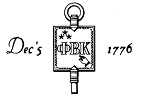History
A Brief History of Phi Beta Kappa
Phi Beta Kappa is the oldest and the most distinguished of all collegiate honorary societies. For more than two hundred years, election to membership has been a recognition of academic excellence achieved in course of completing an education in the liberal arts and sciences at the undergraduate level. The objectives of humane learning encouraged by Phi Beta Kappa include intellectual honesty and tolerance, a broad range of intellectual interests, and a lifelong commitment to the pursuit of learning.Phi Beta Kappa was founded as a literary and debating society on December 5, 1776, at the College of William and Mary. It was the first American society to have a Greek letter name, and in its first meeting, the chapter adopted the emblem of the organization, the Phi Beta Kappa key. Among the earliest members, more than one fourth served with revolutionary forces in the American Revolution, several were instrumental in framing and bringing about the ratification of the American Constitution, and one of the early members, John Marshall, became first Chief Justice of the United States Supreme Court.Since its beginnings, Phi Beta Kappa has changed substantially in its aims, membership, and organization. Originally a secret society, all secrecy was eliminated as early as the 1830s. In its early days a social club similar to today’s fraternities, it developed over the course of the nineteenth century into an academic honor society existing to recognize excellence in liberal learning, and admitting members only after they meet the highest academic standards. For many decades an only male organization, women began to be admitted in 1875, when the chapter at the University of Vermont admitted two women to membership, a step regarded by many at the time as revolutionary. In 1883, the first National Council began, and from that time the society increased steadily in size and stature, adding chapters at institutions carefully selected for the highest academic standards in undergraduate liberal arts programs. In 1905 Alpha of North Carolina chapter was established, the first North Carolina and one of the first chapters chartered among Southern universities after the Civil War.Today there are some 255 Phi Beta Kappa chapters on American college and university campuses, along with over fifty associated alumni organizations which promote the liberal arts and sciences through lectures, scholarships, and awards recognizing the academic achievement of high school and college students. The organization has almost a half million living members. A list of past and present members reads like a Who’s Who of American society, including six American presidents, twelve justices of the Supreme Court, and numerous artistic, intellectual, and political leaders, including notables such as Jane Addams, Leonard Bernstein, Pearl Buck, Samuel Clemens, Rita Dove, Henry James, Helen Keller, Oliver Wendell Holmes, Paul Robeson, Jonas Salk, Booker T. Washington, and Daniel Webster.
The national organization of Phi Beta Kappa and its chapters across the country, along with its alumni associations, carry out active programs to promote the liberal arts and sciences through awards, lectures, scholarships, and prizes. The organization publishes The American Scholar, a well known quarterly journal of American thought. And each year it raises and distributes over one million dollars to benefit students and scholars through its programs.
Symbolism
The key that all PBK members are privileged to wear is practically identical with the silver medal adopted by the founders in 1776. Some time later the stem was added for the purpose of winding pocket watches.
One side of the Key bears the three Greek letters PBK, the initials of the Greek Motto, Philosophia Biouy Kubernetes, which is interpreted to mean: “The Love of Wisdom, the Inspiration of Life”. The three stars indicate the three fundamental principles of the Society–Fraternity, Morality, Literature, and the hand pointing to the stars indicates the high aspirations of the members. On the reverse side the letters S P are the initials of the Latin words, Societas Philosophiae, which are in harmony with the Greek motto on the obverse. Above these initials the name and chapter of the wearer may be engraved.
 The date, December 5, 1776, was engraved on the earliest medals, and indicates the time of the Society’s formal organization. All wearers of the Key are thus assured that they belong to one of the oldest college organizations in this country – the oldest Society formed for the encouragement of scholarship and the union of those engaged in scholarly pursuits.
The date, December 5, 1776, was engraved on the earliest medals, and indicates the time of the Society’s formal organization. All wearers of the Key are thus assured that they belong to one of the oldest college organizations in this country – the oldest Society formed for the encouragement of scholarship and the union of those engaged in scholarly pursuits.
